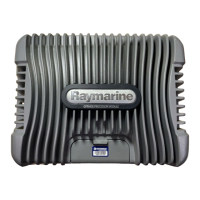G-Series Reference Manual 62
You can now choose to edit the name and color of the track, or to
delete it from the system.
5.8 Heading and course information
You can display a variety of graphical indicators to help monitor
your progress:
• HDG vector
• COG vector
• Wind arrow
• Tide arrow
• Course deviation indicator
Heading and course-over-ground vectors
Your vessel’s heading (HDG) is displayed as a line with an open
arrow head. It does not take account of winds or tides. The course
over ground (COG) indicator shows your vessel’s actual course. It
is displayed as a line with two open arrow heads.
The length of these lines is determined by the distance your boat
will travel in the time you have specified (3 mins, 6 mins or infinite)
in the Chart Setup Menu (see
page 46) at the current speed.
Any times that you specify apply to all chart views and if INFINITE
is selected the vector will extend to the edge of the chart window.
Note: If either the speed over ground or heading data are unavail-
able, vectors cannot be displayed.
Wind and tide arrows
Wind and tides are displayed as lines with solid arrow heads in the
direction of the wind or tidal set. Wind arrows point into your boat
and tidal arrows point away. The width of the arrow indicates
strength.
For the wind arrows feature to work, you must have a wind instru-
ment enabled. For tide arrows, you need a GPS and speed through
water instrument.
To use graphical indicators (arrows)
1. Press the DATA button.
2. Press the CHART VECTORS softkey.
3. Toggle graphical indicators to the required setting on the appro-
priate softkeys.

